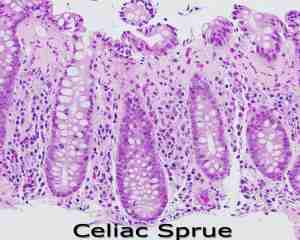

MedFriendly®


Sprue
Sprue is a disorder of the small intestine that causes a
failure to absorb nutrients in food, which then leads to
the passage of a large amount of fat in the feces
(poop). The intestine is a tube shaped structure that is
part of the digestive tract. It stretches from an opening
in the stomach to the anus (rear end) and occupies
most of the lower parts of the belly. The small intestine
is a part of the intestine that takes in all of the nutrients
that the body needs. The type of sprue discussed in
this definition is also known as cachexia aphtosa and
catarrhal dysentery.
FEATURED BOOK: Celiac Disease: A Hidden Epidemic
loss, weakness, paleness, poor appetite, pain in the bones, muscle cramps, a smooth
and shiny tongue, and open sores in the lining of the intestine. There are two forms of
sprue. One form occurs mostly in tropical regions of the world (areas that are hot and
moist). The other form, known as celiac sprue is more common and is due to sensitivity
to a protein found in wheat, known as gluten. Sprue occurs in both children and adults.
In dentistry, sprue refers to metal or wax that is used to make the opening(s) for liquid
metal to flow into a mold to make a cast. The metal that later fills these holes are also
known as sprue. Sprue comes from the Dutch word "sprouw" meaning "a kind of tumor."
"Where Medical Information is Easy to Understand"™















